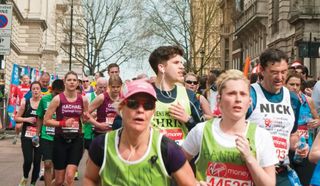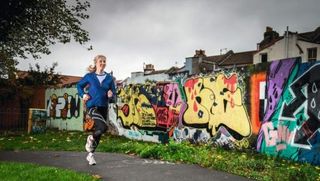
When it comes to outdoor photography, 'If it moves, shoot it!' is a great motto to follow. With a packed sporting calendar now taking place all-year round, we'll teach you all the shooting skills you need to know to improve your action photography - just in time for this year's London Marathon!
We start off by explaining which type of lenses you'll need to best capture the action in various shooting situations when trying to capture the action of the London Marathon 2016. We reveal tried-and-trusted techniques for capturing sharp action shots and show you how to pan like a pro.
Then we round things off with some more advanced action-photography skills. Although we've concentrated on the London Marathon 2016, action photography techniques aren't necessarily restricted to sports. In our comprehensive guide, we also show you some cool methods for capturing creative shots of performers – and, of course, all these techniques can be applied to absolutely any subjects that move!
What lenses do I need to photograph the London Marathon 2016?
It all depends on what you're shooting! It really comes down to how close you can get to subjects, and how tightly you want to crop. Telephotos are the obvious choice – but there are other types of lens that can prove useful for sports…

1. Wide-angle zoom
If you're shooting in a stadium, or near some gorgeous landmarks during the London Marathon, think about getting some wide shots of the whole setting rather than just focusing on the runners.
You'll need a really wide focal length around 10-12mm on a typical digital SLR, or around 16-17mm on full-frame cameras. Popular lens options include Canon's EF-S 10-22mm f/3.5-4.5, Nikon's AF-S DX 10-24mm f/3.5-4.5G ED, Tokina's 11-16mm f/2.8, or Sigma's 10-20mm f/3.5.
These ultra-wides can also be used for dramatic shots of some extreme sports such as skateboarding and snowboarding.
Get daily insight, inspiration and deals in your inbox
Get the hottest deals available in your inbox plus news, reviews, opinion, analysis and more from the TechRadar team.
2. Midrange zoom
If you're photographing marathon runners, or sports where you're fairly close to the sidelines, such as rugby or BMX bikes you'll find a midrange zoom will get you close enough to at least some of the action – while being able to get some of the surroundings in shot to add context.
Midrange zoom lenses give you more choice of focal lengths without the need for changing lenses, or buying new ones. Consider fast midrange zooms like Canon's EF 24-70mm f/2.8L, Nikon's AF-S 24-70mm f/2.8G ED or Sigma's 24-70mm f/2.8. A typical 18-55mm kit lens will be just fine, too.
3. Telephoto zoom
If you're unable to get close to your subjects as they're on the other side of the pitch – or because you're not able to get too close to the runner's at the London Marathon – there's nothing worse then ending up with tiny shots of your subjects with big, boring backgrounds.
You'll need a telephoto zoom lens with a long maximum focal length if you are going to fill the frame with your subjects. If you're by the side of the London Marathon's course, you may be able to get away with a 70-200mm lens (check out Canon's EF 70-200mm f/4L IS or Nikon AF-S 70-200mm f/2.8G ED VR II), but you may well need an even bigger super-telephoto zoom, such as Canon's EF 100- 400mm f/4.5-5.6L, Nikon's AF VR 80-400mm f/4.5-5.6 or the more affordable Sigma's 120-400mm f/4.5-5.6 OS lens. For marathon runners, we recommend a focal length of 50mm.
I'm told I need a 'fast' lens? What is this?
Fast lenses refer to the wider-than-average constant apertures found on more expensive lenses, such as a 70-200mm f/2.8 or f/4 lenses. They're called fast lenses, as at an aperture of f/2.8 or f/4 you're able to obtain faster shutter speeds – ideal for freezing your subjects' action.
The wide apertures will also really bring your subjects out from their surroundings for more striking results. The other benefit of using these lenses is that their wide apertures (and therefore your exposure, such as f/4 at 1/500 sec) are constant through the focal length range, whether you're shooting at 70mm or 200mm: whereas with cheaper lenses the aperture will change from, say, f/3.5 at its widest focal length to f/5.6 at its longest end.
Is it really worth using an image-stabilised lens?
Image stabilisation (or IS) is readily available on lenses from budget to pro-level, and this is a good thing for photographers, as a lens with IS can help to nullify camera shake when shooting handheld, which means sharper results all round.
Canon's EF-S 55-250mm IS, for example, has a '4-stop Image Stabilizer', which means you can use shutter speeds up to 16 times slower than normal and still capture shots without unwanted blur, such as 1/15 sec instead of 1/250 sec.
Some IS lenses have two stabilisation settings, one for normal shooting, and one for use when panning by correcting simply for vertical shake.
Tech tip
Telephoto focal lengths capture a shallower depth of field than wide-angle ones. So, coupled with a wide aperture of around f/4 or f/5.6, it will give your shots that pro look, with blurred backgrounds to make subjects stand out in the scene.
Current page: Choosing the right lens for sports photography
Next Page Getting the perfect photo